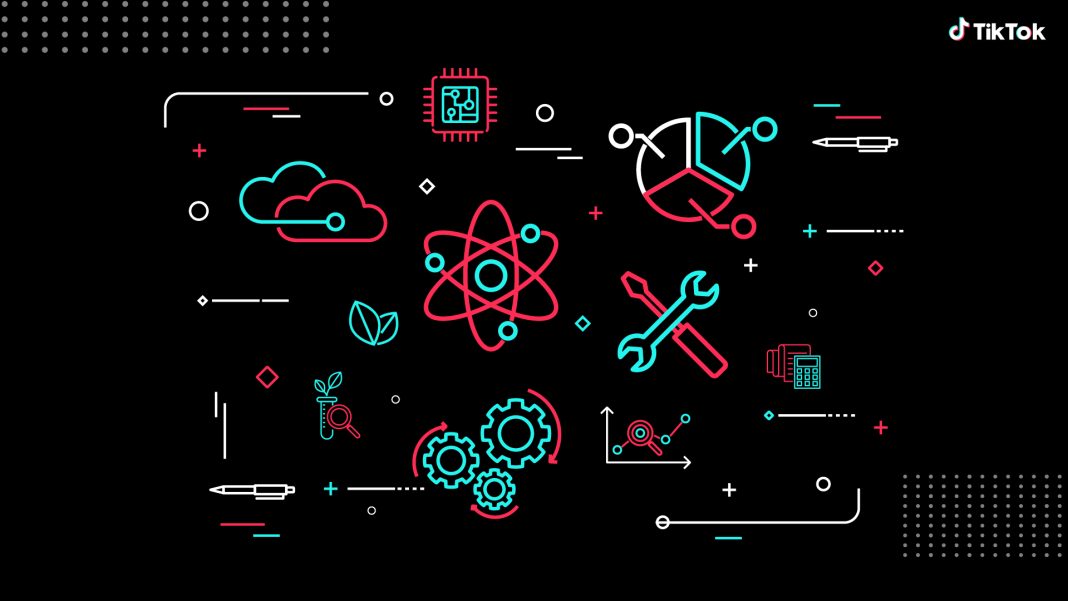Few apps seem more ubiquitous on people’s phones–mine included–than the social media giant TikTok. Reported by Business of Apps to have acquired over 3 billion downloads since its launch in 2016, ByteDance’s product has exploded to permeate cultures worldwide, expanding to cover not only entertainment, but shopping, live streams, slideshows, news, and STEM. As time passes, the platform seems to resemble a search engine more and more, even building in hyperlinks to comment sections based on user engagement. Their relatively new STEM feed is thus, in many ways, an unsurprising addition to the app that seems to cover so many bases. Still, dedicated science and math content is far from what TikTok is known for, and, with the execution of the STEM feed, maybe rightly so. For all of its ease of access and bite-sized information, TikTok’s new feature struggles to escape the pre-existing problems of the platform.
Located right next to the “Following” feed is the STEM tab, which TikTok’s website rather blandly describes as a feed that “displays videos related to science, technology, engineering and mathematics (STEM) on TikTok.” A link beneath the one-sentence description leads to a more detailed article on its launch, where TikTok describes an intent to merge the platform’s preexisting STEM content into an easily accessible page. Little is mentioned about what videos get priority, or even what counts as content that would fit the requirements of the feed. Notably, the article does mention a pairing with two companies, Common Sense Media and Poynter, to curb misinformation for the new tab on the platform.
In terms of misinformation, however, TikTok has garnered an already tarnished reputation. A 2022 report published by investigator NewsGuard revealed that, when searching for contemporary news topics, almost twenty percent of results contained some form of misleading or false information. The report also mentioned that of the over 100 million videos TikTok removed at the beginning of 2022, “Less than one percent of these were removed for violating TikTok’s ‘integrity and authenticity guidelines,’” the umbrella term for videos that contain false statements. Another article published in BMJ Global Health focused on the monkeypox outbreak, using criteria from the Journal of the American Medical Association to rate videos found on TikTok. BMJ reported that out of 85 videos, “two assessed all content topics and…No video met all JAMA criteria.”
This isn’t to say that TikTok is completely faulty at screening for misinformation, but it does cast doubt on their ability to monitor STEM content enough to create a focused hub. To determine if the new tab did offer a legitimate ‘educational’ experience, I opened the feed on my phone for a little over an hour, liking videos to curate the algorithm, trying to figure out what exactly it’s showing to users. As a whole, the content was underwhelming. Instead of the curated posts featured in TikTok’s announcement article, most videos were guides to solving high school math problems, low-resolution chemistry equations, and generally amateur homework help. There were a few high-quality works, but they were few and far between, mostly taking a backseat to the sea of smaller videos. The common factor was audience engagement: few TikToks had over 100 likes or more than ten comments, which questions as to whether anyone actually even uses the feed.
On my “For You” page, I already get the occasional astronomy or science video, and the engagement and quality of those productions beats out even the more elaborate videos on the STEM feed. Interestingly enough though, my FYP is also where I run into the most misinformation. I recently saw a short-form TikTok presenting an image of the night sky that zooms in to focus on a very grainy black hole labeled TON 618. TON 618 does exist, but it’s impossible to see in a picture the way the creator suggested; a small but false detail. This combination of real data and misinformation seems to encompass a non-negligible part of science content on the platform, which can both engage audiences but also mislead them quite easily. In reference to the black hole, it’s unclear if even the original poster knew that their picture was doctored.
With this in mind, the STEM page seems to be almost performative–both a knee-jerk reaction to closer government scrutiny and a cautious step into the search engine industry. The best STEM content exists outside of its new hub, and in reality almost nobody is using the app for research or their primary news source. As for whether the new feed matters, the answer is an unfortunate, resounding no.

